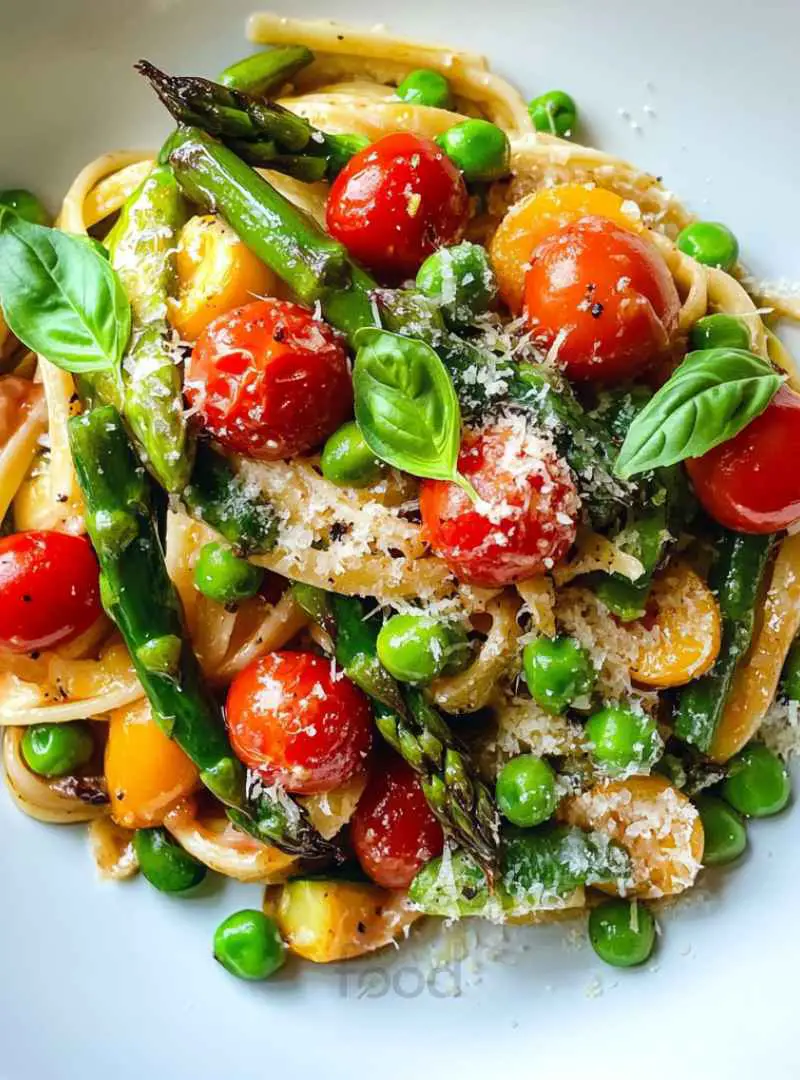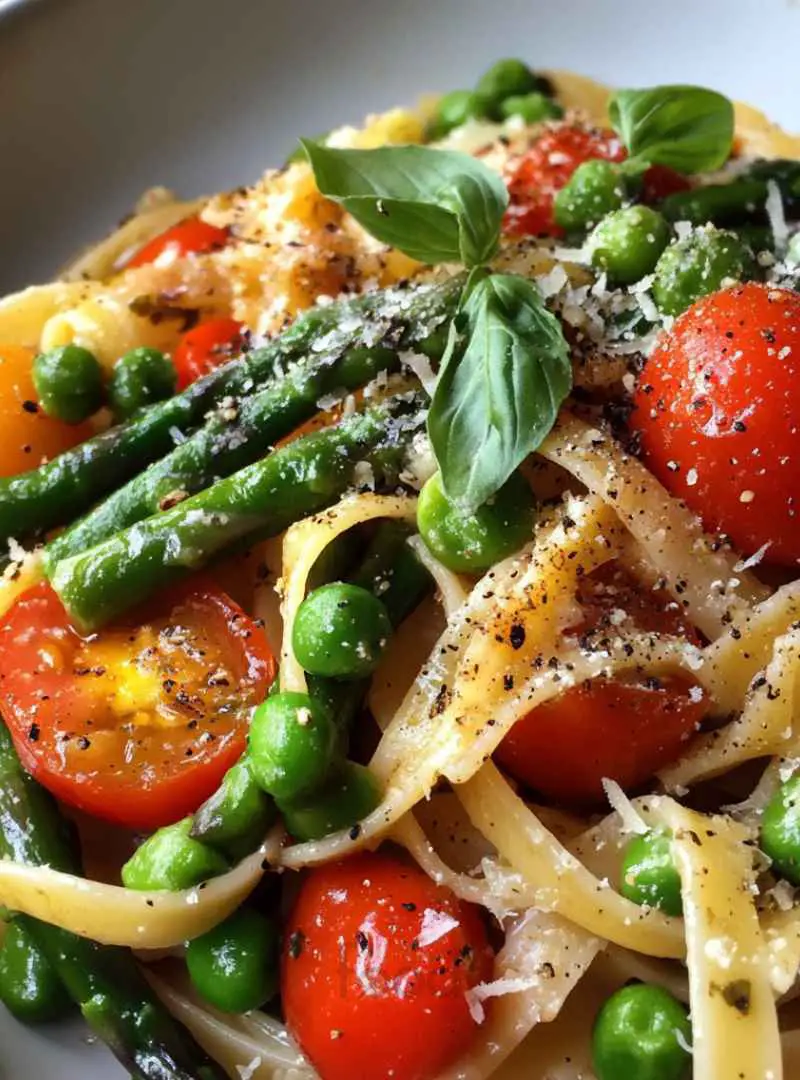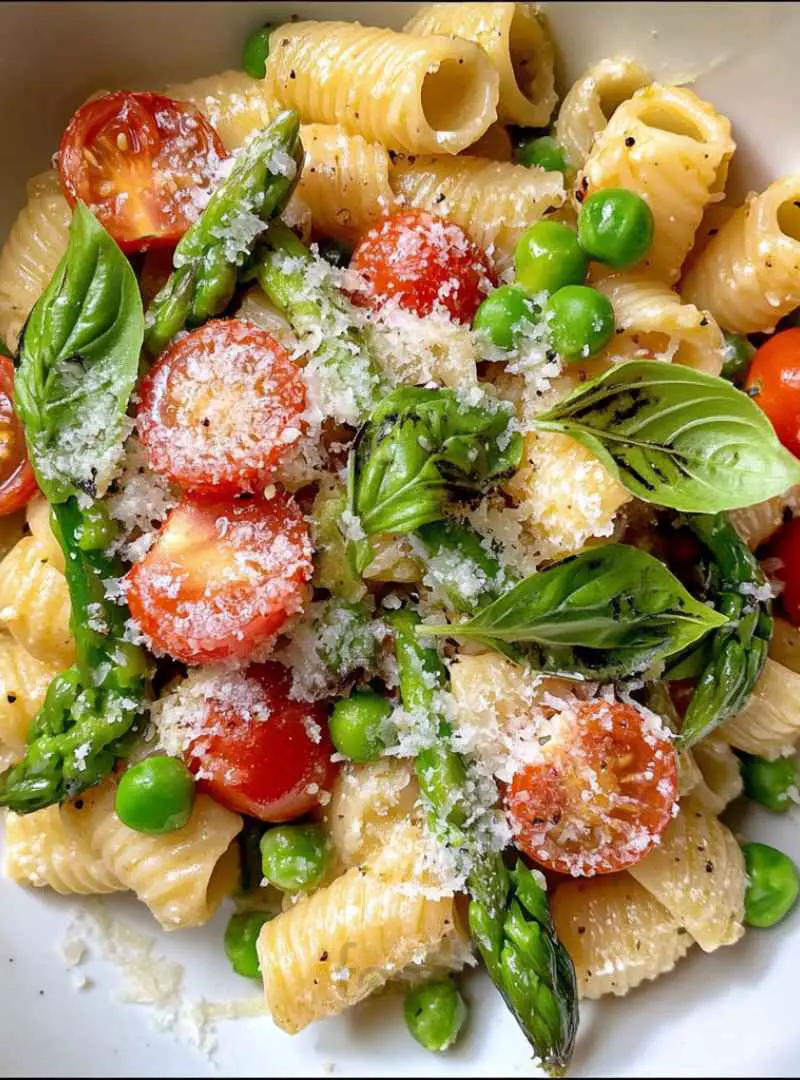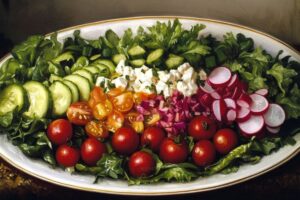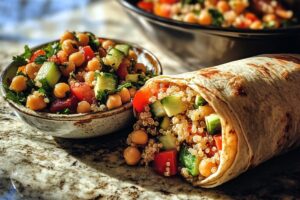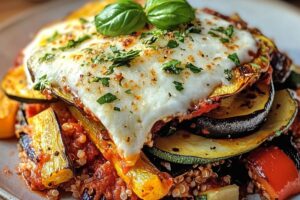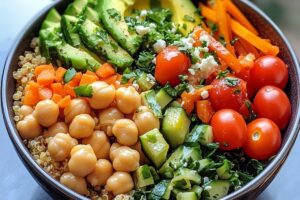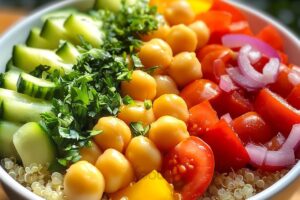Spring is a time of renewal, and what better way to celebrate than with a fresh and vibrant dish? Spring vegetable pasta is a delightful meal that captures the essence of the season. This dish is not only colorful but also packed with nutrients, making it a perfect choice for a light lunch or dinner. With its combination of seasonal vegetables and pasta, it brings a burst of flavor to your table.
What is Spring Vegetable Pasta?
Spring vegetable pasta is a delightful dish that features a variety of fresh vegetables, tossed with your favorite pasta. The ingredients often include asparagus, peas, cherry tomatoes, and zucchini, all of which are in season during spring. This dish is versatile, allowing you to customize it based on your preferences or what you have on hand. The result is a colorful, nutritious meal that is sure to please everyone.
Why Choose Spring Vegetable Pasta for Your Meals?
Choosing spring vegetable pasta for your meals comes with numerous benefits. First, it’s a great way to incorporate seasonal produce into your diet. Fresh vegetables are not only tastier but also more nutritious. Additionally, this dish is quick and easy to prepare, making it perfect for busy weeknights. Plus, it’s a fantastic option for those looking to eat lighter as the weather warms up. With its vibrant colors and fresh flavors, spring vegetable pasta is sure to brighten your dining experience.
Ingredients for Spring Vegetable Pasta
To create a delicious spring vegetable pasta, you’ll need a selection of fresh ingredients that highlight the season’s bounty. Here’s what you’ll need:
- 8 oz pasta: Choose your favorite type, such as spaghetti, penne, or fusilli.
- 2 tablespoons olive oil: This adds a rich flavor and helps sauté the vegetables.
- 1 small onion: Finely chopped for a sweet and savory base.
- 2 garlic cloves: Minced to enhance the dish’s aroma and taste.
- 1 cup asparagus: Trimmed and cut into 1-inch pieces for a crunchy texture.
- 1 cup cherry tomatoes: Halved to add a burst of sweetness.
- 1 cup peas: Fresh or frozen, they bring a pop of color and nutrition.
- 1 zucchini: Sliced to add a mild flavor and vibrant green color.
- Salt and pepper: To taste, enhancing the overall flavor.
- 1/2 teaspoon red pepper flakes: Optional, for a hint of heat.
- 1/4 cup fresh basil: Chopped, to add a fragrant herbal note.
- 1/4 cup grated parmesan cheese: Optional, for a creamy finish.
These ingredients come together to create a delightful spring vegetable pasta that is not only tasty but also visually appealing. Feel free to adjust the quantities based on your preferences or the number of servings you need. The beauty of this dish lies in its flexibility, allowing you to experiment with different vegetables and flavors!
Preparation of Spring Vegetable Pasta
Now that you have gathered all the ingredients, it’s time to prepare your spring vegetable pasta. This process is simple and quick, allowing you to enjoy a delicious meal in no time. Follow these easy steps to create a vibrant dish that celebrates the flavors of spring.
Step 1: Cook the Pasta
Start by boiling the pasta. In a large pot, bring salted water to a rolling boil. Once boiling, add your chosen pasta. Cook according to the package instructions until it reaches an al dente texture. This usually takes about 8 to 10 minutes. Remember to reserve 1 cup of the pasta water before draining. This starchy water will help bind the sauce later. After draining, set the pasta aside while you prepare the vegetables.
Step 2: Sauté the Vegetables
Next, it’s time to sauté the vegetables. In a large skillet, heat 2 tablespoons of olive oil over medium heat. Once the oil is hot, add the finely chopped onion. Sauté for about 3 to 4 minutes until the onion becomes translucent. Then, stir in the minced garlic and cook for an additional minute until it becomes fragrant. Now, add the asparagus, cherry tomatoes, peas, and zucchini to the skillet. Season with salt, pepper, and red pepper flakes if you like a bit of heat. Sauté the mixture for about 5 to 7 minutes. You want the vegetables to be tender yet still vibrant in color.
Step 3: Combine Pasta and Sauce
Once the vegetables are ready, it’s time to combine everything. Add the cooked pasta to the skillet with the sautéed vegetables. Toss everything together gently, ensuring the pasta is well coated with the vegetable mixture. If the dish seems dry, add the reserved pasta water a little at a time until you reach your desired consistency. This will help create a light sauce that clings to the pasta beautifully. Finally, stir in the chopped basil and adjust the seasoning with salt and pepper to taste.
Step 4: Serve
Your spring vegetable pasta is now ready to be served! Plate the pasta hot, and if you like, garnish it with grated parmesan cheese for an extra touch of flavor. This dish is best enjoyed fresh, but it also makes for great leftovers. Enjoy the delightful colors and flavors of spring in every bite!
Variation of Spring Vegetable Pasta
One of the best things about spring vegetable pasta is its versatility. You can easily swap out ingredients or add new ones to suit your taste. This section will explore some seasonal vegetable swaps and protein additions that can elevate your dish even further.
Seasonal Vegetable Swaps
Spring is a wonderful time to experiment with different vegetables. If you can’t find asparagus or zucchini, don’t worry! Here are some tasty alternatives:
- Broccoli: Cut into small florets, broccoli adds a nice crunch and is packed with nutrients.
- Bell Peppers: Any color will do! They add sweetness and a pop of color to your dish.
- Carrots: Thinly sliced or julienned, carrots bring a hint of sweetness and vibrant orange color.
- Spinach: Fresh spinach can be added at the end of cooking for a boost of nutrients and a lovely green hue.
- Green Beans: Trimmed and cut into bite-sized pieces, they add a satisfying crunch.
Feel free to mix and match these vegetables based on what’s in season or what you have on hand. The goal is to create a colorful and nutritious dish that celebrates the flavors of spring!
Protein Additions for Spring Vegetable Pasta
If you want to make your spring vegetable pasta more filling, consider adding a protein source. Here are some great options:
- Grilled Chicken: Sliced grilled chicken breast adds lean protein and pairs well with the fresh flavors.
- Shrimp: Sautéed shrimp cooks quickly and adds a delicious seafood twist to your pasta.
- Tofu: For a vegetarian option, add cubed tofu. It absorbs flavors well and adds a nice texture.
- Chickpeas: Canned or cooked chickpeas are a great plant-based protein that adds heartiness to the dish.
- Bacon or Pancetta: For a savory touch, crispy bacon or pancetta can add a delightful crunch and flavor.
By incorporating these protein additions, you can create a more balanced meal that satisfies your hunger while still celebrating the vibrant flavors of spring vegetable pasta.
Cooking Note for Spring Vegetable Pasta
When preparing spring vegetable pasta, there are a few cooking tips to keep in mind. These will help you achieve the best flavor and texture in your dish. First, always use fresh vegetables when possible. Fresh produce not only tastes better but also retains more nutrients. If you can, visit a local farmer’s market to find the freshest ingredients.
Another important tip is to avoid overcooking the vegetables. You want them to be tender yet still crisp. Overcooked vegetables can lose their vibrant colors and essential nutrients. To maintain their freshness, sauté them just until they are bright and tender. This will ensure that your spring vegetable pasta looks as good as it tastes.
Additionally, don’t forget to taste as you go! Adjust the seasoning to your liking. A little extra salt or a squeeze of lemon juice can elevate the flavors significantly. If you prefer a creamier sauce, consider adding a splash of heavy cream or a dollop of ricotta cheese at the end. This will give your dish a rich, luxurious texture.
Lastly, remember that the reserved pasta water is your friend. This starchy water can help bind the sauce to the pasta, creating a cohesive dish. Add it gradually until you reach your desired consistency. With these cooking notes in mind, you’ll be well on your way to creating a delicious spring vegetable pasta that everyone will love!
Serving Suggestions for Spring Vegetable Pasta
Once you’ve prepared your delightful spring vegetable pasta, it’s time to think about how to serve it. This dish is versatile and can be paired with various side dishes and beverages to enhance your dining experience. Here are some suggestions to elevate your meal.
Pairing with Side Dishes
To complement your spring vegetable pasta, consider serving it with light and refreshing side dishes. Here are a few ideas:
- Garlic Bread: A classic choice, garlic bread adds a crunchy texture and rich flavor that pairs perfectly with pasta.
- Mixed Green Salad: A simple salad with fresh greens, cucumbers, and a light vinaigrette can balance the meal and add extra nutrients.
- Roasted Vegetables: Seasonal roasted vegetables, such as bell peppers and carrots, can enhance the dish’s flavors and provide additional color.
- Caprese Salad: Fresh mozzarella, tomatoes, and basil drizzled with balsamic glaze make for a refreshing side that complements the pasta.
- Grilled Corn on the Cob: Sweet and juicy corn adds a fun, summery touch to your meal.
These side dishes not only enhance the flavors of your spring vegetable pasta but also create a well-rounded meal that is satisfying and enjoyable.
Wine Pairings for Spring Vegetable Pasta
Choosing the right wine can elevate your dining experience. Here are some excellent wine pairings for your spring vegetable pasta:
- Sauvignon Blanc: This crisp white wine has bright acidity and herbal notes that complement the fresh vegetables beautifully.
- Pinot Grigio: Light and refreshing, Pinot Grigio pairs well with the dish’s vibrant flavors without overpowering them.
- Chardonnay: A lightly oaked Chardonnay can add a creamy texture that complements the pasta, especially if you’ve added cheese.
- Rosé: A chilled rosé is perfect for spring, offering fruity notes that enhance the dish’s freshness.
- Light Red Wines: If you prefer red, opt for a light-bodied wine like Pinot Noir, which won’t overshadow the delicate flavors of the vegetables.
With these wine pairings, you can create a delightful dining experience that highlights the fresh and vibrant flavors of your spring vegetable pasta.
Tips for Perfecting Your Spring Vegetable Pasta
Creating the perfect spring vegetable pasta is all about attention to detail and a few helpful tips. With these suggestions, you can elevate your dish and impress your family and friends. Here are some essential tips to keep in mind:
- Choose Quality Ingredients: Always opt for fresh, high-quality vegetables. Seasonal produce not only tastes better but also adds vibrant colors to your dish. Visit local farmers’ markets for the freshest options.
- Cook Pasta Al Dente: Make sure to cook your pasta until it is al dente. This means it should be firm to the bite. Overcooked pasta can become mushy and lose its appeal.
- Don’t Skip the Pasta Water: Remember to reserve some pasta water before draining. This starchy water is a great way to adjust the sauce’s consistency and helps it cling to the pasta.
- Season Generously: Don’t be shy with your seasonings! Salt and pepper are essential, but consider adding herbs and spices to enhance the flavors. Fresh herbs like basil or parsley can make a big difference.
- Mix and Match Vegetables: Feel free to experiment with different vegetables based on what you have available. The more colorful your dish, the more appealing it will be!
- Finish with Fresh Herbs: Adding fresh herbs at the end of cooking preserves their flavor and aroma. This simple step can elevate your dish significantly.
- Serve Immediately: Spring vegetable pasta is best enjoyed fresh. Serve it right after cooking to maintain the vibrant colors and textures of the vegetables.
- Garnish for Presentation: A sprinkle of grated cheese or a few extra basil leaves can enhance the visual appeal of your dish. A beautiful presentation makes the meal even more enjoyable.
By following these tips, you can create a delicious and visually stunning spring vegetable pasta that will delight your taste buds and impress your guests. Enjoy the process and have fun experimenting with flavors!
Breakdown of Time for Spring Vegetable Pasta
Understanding the time needed to prepare your spring vegetable pasta can help you plan your meal better. Here’s a simple breakdown of the time involved in each step of the process, ensuring you can enjoy this delightful dish without any rush.
Prep Time
The prep time for spring vegetable pasta is quite short. You’ll need about 10 minutes to gather and prepare your ingredients. This includes chopping the vegetables, measuring out the pasta, and getting everything ready for cooking. Having everything prepped in advance makes the cooking process smoother and more enjoyable.
Cooking Time
Once you start cooking, the total cooking time is approximately 15 minutes. This includes boiling the pasta and sautéing the vegetables. The quick cooking time is one of the best features of this dish, making it perfect for busy weeknights or last-minute meals. You can have a delicious, fresh meal on the table in no time!
Total Time
In total, you can expect to spend about 25 minutes from start to finish. This includes both prep and cooking time. With just a little bit of effort, you’ll have a vibrant and tasty spring vegetable pasta ready to serve. It’s a fantastic option for anyone looking to enjoy a healthy meal without spending hours in the kitchen!
Nutritional Information for Spring Vegetable Pasta
Understanding the nutritional content of your meals is essential for maintaining a balanced diet. Spring vegetable pasta is not only delicious but also packed with nutrients. Here’s a breakdown of the nutritional information for a serving of this vibrant dish.
Calories
One serving of spring vegetable pasta contains approximately 350-400 calories, depending on the type of pasta used and any additional ingredients you may add. This makes it a light yet satisfying meal option. The combination of fresh vegetables and pasta provides a good balance of energy without being overly heavy.
Protein
In terms of protein, a serving of spring vegetable pasta typically offers around 12-15 grams. This amount can vary based on the pasta type and any protein additions, such as chicken, shrimp, or tofu. If you’re looking to increase the protein content, consider adding grilled chicken or chickpeas, which can boost the overall nutritional value of your meal.
Sodium
The sodium content in spring vegetable pasta is generally around 300-400 milligrams per serving. This can vary based on how much salt you add during cooking and whether you use salted pasta water. To keep sodium levels in check, you can opt for low-sodium broth or seasonings. Always taste as you go to ensure you’re not over-salting your dish.
Overall, spring vegetable pasta is a nutritious choice that provides a good mix of carbohydrates, protein, and essential vitamins from the fresh vegetables. Enjoy this delightful dish knowing it supports your health while tantalizing your taste buds!
FAQs about Spring Vegetable Pasta
Can I use different types of pasta for Spring Vegetable Pasta?
Absolutely! One of the great things about spring vegetable pasta is its versatility. You can use any type of pasta you prefer, such as spaghetti, penne, fusilli, or even whole grain options. Each type of pasta will bring a unique texture to the dish. Just remember to adjust the cooking time according to the pasta you choose, ensuring it reaches that perfect al dente texture!
How can I make Spring Vegetable Pasta vegan?
Making spring vegetable pasta vegan is simple! Just omit the parmesan cheese or replace it with a vegan cheese alternative. You can also enhance the dish with additional plant-based proteins, such as chickpeas or tofu. Using vegetable broth instead of water for cooking the pasta can add extra flavor. With these adjustments, you’ll have a delicious vegan meal that everyone can enjoy!
What other vegetables can I add to Spring Vegetable Pasta?
The possibilities are endless when it comes to adding vegetables to your spring vegetable pasta! Consider incorporating bell peppers, broccoli, spinach, or even artichokes. Seasonal vegetables like snap peas or radishes can also add a delightful crunch. Feel free to experiment with whatever fresh produce you have on hand. The more colorful your dish, the more appealing it will be!
How do I store leftovers of Spring Vegetable Pasta?
Storing leftovers of spring vegetable pasta is easy! Allow the pasta to cool completely before transferring it to an airtight container. It can be stored in the refrigerator for up to 3 days. When you’re ready to enjoy it again, simply reheat in a skillet over medium heat, adding a splash of water or olive oil to prevent sticking. You can also microwave it in short intervals, stirring in between. Enjoy your delicious leftovers!
Conclusion
In summary, spring vegetable pasta is a delightful dish that brings together the best of the season. It’s not only colorful and vibrant but also packed with nutrients from fresh vegetables. This dish is quick to prepare, making it perfect for busy weeknights or casual gatherings. By incorporating seasonal produce, you can enjoy a meal that is both delicious and healthy.
Recap of the Benefits of Spring Vegetable Pasta
Spring vegetable pasta offers numerous benefits. First, it allows you to enjoy a variety of fresh vegetables, which are essential for a balanced diet. The dish is versatile, letting you customize it based on your preferences or what you have on hand. Additionally, it’s a light meal that can help you feel satisfied without being overly heavy. With its quick preparation time, you can have a nutritious dinner ready in just 25 minutes!
Encouragement to Try the Recipe
We encourage you to try making spring vegetable pasta at home. Gather your favorite seasonal vegetables and pasta, and follow the simple steps outlined in this article. Whether you’re cooking for yourself, family, or friends, this dish is sure to impress. Enjoy the fresh flavors of spring and the joy of cooking with vibrant ingredients. Happy cooking!
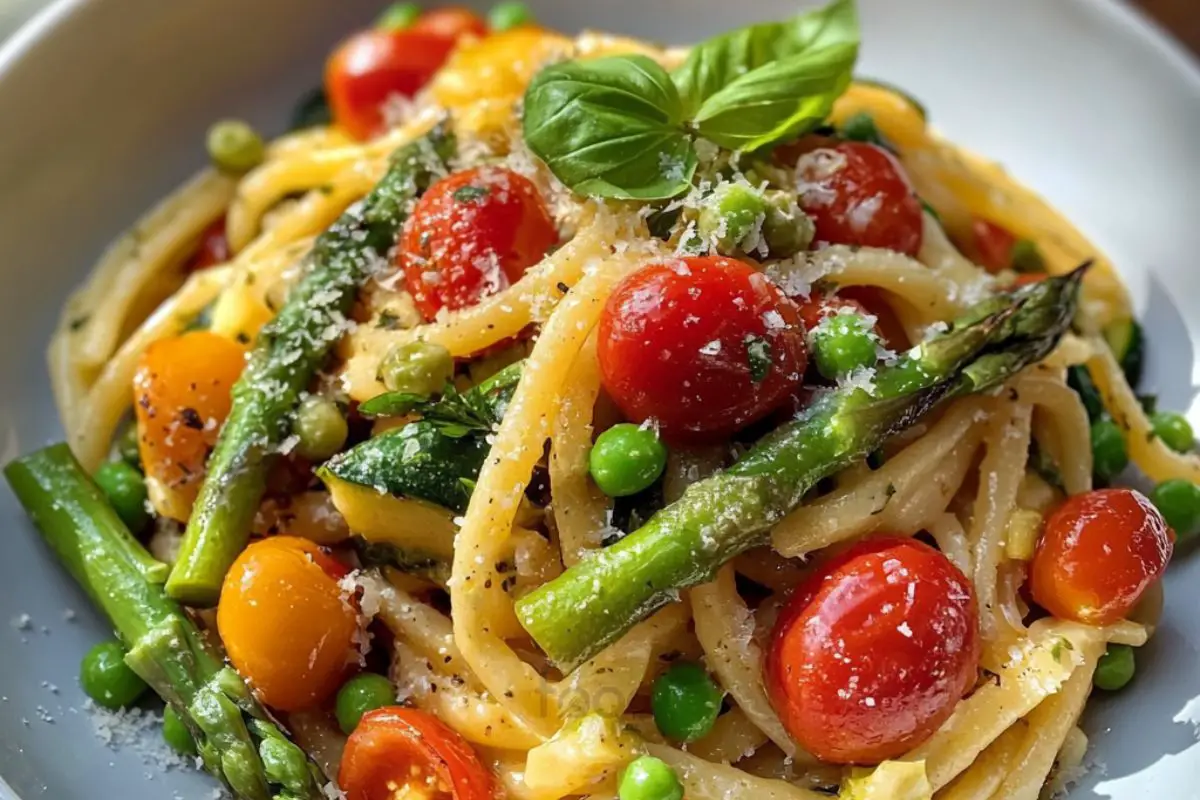
Spring Vegetable Pasta
Ingredients
Equipment
Method
- Boil the pasta in salted water according to package instructions until al dente. Reserve 1 cup of pasta water before draining.
- In a large skillet, heat olive oil over medium heat. Sauté the onion for 3-4 minutes until translucent, then add garlic and cook for another minute.
- Add asparagus, cherry tomatoes, peas, and zucchini to the skillet. Season with salt, pepper, and red pepper flakes. Sauté for 5-7 minutes until vegetables are tender but vibrant.
- Combine the cooked pasta with the sautéed vegetables in the skillet. Toss gently, adding reserved pasta water as needed to create a light sauce. Stir in fresh basil and adjust seasoning.
- Serve hot, garnished with grated parmesan cheese if desired.

